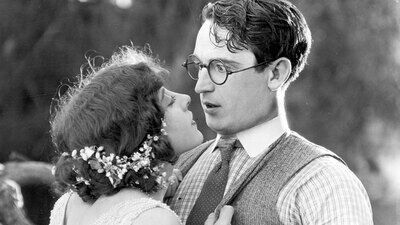What separates “Girl Shy” from its predecessors (and the films made by the two other leading comic stars of the day, Buster Keaton and Charlie Chaplin) is largely the unique quality of Harold Lloyd as a romantic lead. He has a softness and inherent vulnerability that make it easy to root for him to get the girl, alongside his deftness with pratfalls and death-defying stuntwork that frequently defined comedy films of the time. Keaton’s famously stony face made him a little less accessible in romantic storylines, and Chaplin, with his painstakingly built Little Tramp character, intentionally feels as though he belongs to an earlier time. Most importantly, the romantic elements of Keaton and Chaplin’s films were treated as almost wholly separate from the comedy. The focus was primarily on the comedic set pieces that allowed their stars to shine, and their relationships with women – though often touching, as we see with Chaplin’s love for a blind woman in “City Lights” – are generally not a source of humor.

But that’s not the case in “Girl Shy,” which uses the interpersonal liaisons between men and women for laughs – both broadly, as we watch Harold struggle with the concept of the fairer sex to comedic effect, and more specifically, as Mary is brought into his shenanigans and even takes part in them. Since Mary is not just along for the ride but an active participant in the film’s comedic sequences, their connection in a way that is warm and – crucially, since this is a rom-com – genuinely funny.
In the first part of “Girl Shy,” the comedy is rooted in dynamics between men and women. The book that Harold Meadows (Harold Lloyd) is writing is a guide to attracting women – despite his complete lack of experience in the field – and as we see him dreaming up each chapter, the film features a short vignette of Harold exercising different tactics to win over different types of women. The two that they show us are “The Vamp” and “The Flapper” – two popular feminine stereotypes of the 1920s, both of which “Girl Shy” satirizes. Audiences of the time would have recognized these supposed types as well as many modern viewers would be able to identify a “Manic Pixie Dream Girl” or a “Not Like Other Girls Girl” on screen. Not only does it create a parody of these characters, but it also lends a mocking eye to their male counterparts: The Vamp is romanced by a cold and indifferent lothario, while the Flapper is won over by a cruel lummox who asserts his masculinity.
There are typical comedic set pieces in “Girl Shy”, including an extended chase sequence in which Harold exchanges a variety of different vehicles as he races to stop Mary from getting married, none of which serve him well for more than a minute or two. We’re also treated to some bits of business as Harold helps Mary prevent a conductor from discovering her pet Pomeranian while on a no-dogs-allowed train, a cover-up that sees him bark like a dog (amazingly, a joke that still works even without sound), reluctantly munch on a dog treat, and hide the Pomeranian underneath the long beard of a fellow passenger. But aside from these structured set pieces, a great deal of the comedy is more restrained and interpersonal – it taps into a style of humor that somehow feels more modern than many of its counterparts, which rely heavily on slapstick.

